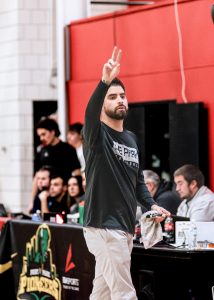Less may be more from long range
December 5, 2017
Point Park basketball has undergone a swift transformation in the last year.
Not only has the program transitioned its personnel for the first time in nearly three decades, it is also in the process of changing the style of play that has been known for since the early 1990s.
Last week, the team’s evolved approach was evident and full of irony.
Point Park defeated Rio Grande in the River States Conference opener last week at home in a game that came down to the buzzer. The Pioneers used only nine attempts from beyond the arc in their 81-79 victory over the RedStorm, making five 3-pointers in the process. They took only two 3-pointers in the first half, making them both.
Point Park’s offense worked the ball inside and was effective in transition to shoot 52 percent from the field on the night. It marked the second straight game the Pioneers shot over 50 percent from the field.
The former game against Washington Adventist resulted in just four made treys for the Pioneers on 18 attempts. Point Park made up for the missed long balls by feeding the ball down low to its 6-foot-5 senior Fousseini Konate, who dropped 22 points in the win.
So far this year Point Park has made five-or-fewer 3-pointers in five games, matching the total from all of last year. It happened only twice the year before last.
The team’s amount of made 3-pointers are down this year, but Point Park’s shooting percentage from long range isn’t far off from its averages in the past decade.
Only two Point Park teams since 2006 have attempted fewer 3-pointers per game.
The 2009-10 team attempted 17.6 per game and finished 9-16, missing the postseason. Last year’s Point Park team attempted the most treys than its previous five seasons, putting up 29.11-per-game and missing the playoffs for the first time since that 2009-10 season. Last year’s team also attempted the most 3-pointers for Point Park since the 2004-05 season.
The other time Point Park attempted this few 3-pointers in recent memory was in 2006-07 when the Pioneers launched an average of 17 treys per contest. That team went 29-2 and is the last Point Park squad to appear in the national tournament.
Let’s go back to the Rio Grande win.
Point Park’s nine 3-pointers attempted against Rio Grande were the fewest in a single game for the program since that 2006-07 season. That team attempted fewer than ten long balls three times on the season and made 6.1 3-pointers-per-game.
While the Pioneers largely avoided the long ball last Wednesday against Rio Grande, it was the three that won them the game.
Point Park’s 6-foot-6 forward Aaron Barlow, the biggest man on the court for the Pioneers, grabbed a loose ball with ten seconds left on the clock on Rio Grande’s end of the floor.
The first-year Pioneer got the ball out to guard Daniel King down by one with time winding down. King began penetrating the RedStorm defense as he had all game when he began to lose possession. He kicked it out to Barlow, who was set up outside the arc and calling for the pass.
Barlow flicked his left wrist for only the sixth time this year and connected for his second long ball of the season to push Point Park past Rio Grande as time expired.
Head coach Gabe Bubon overheard me talking to the scorer’s table after the game confirming that Point Park only took nine threes on the night. His response says
everything you need to know about the new direction of the
Pioneers.
“We took that many?”
Point Park this year has worked the ball inside to its big men and has taken more high-percentage shots. Only when necessary or when the Pioneers have struggled to penetrate down inside have they turned to the long ball.
The conference schedule is just kicking off for the Pioneers, who face an uphill battle in a loaded River States Conference this year. Time will tell if the more organized offense combined with an aggressive defense will hold up throughout the duration of the team’s season.



















